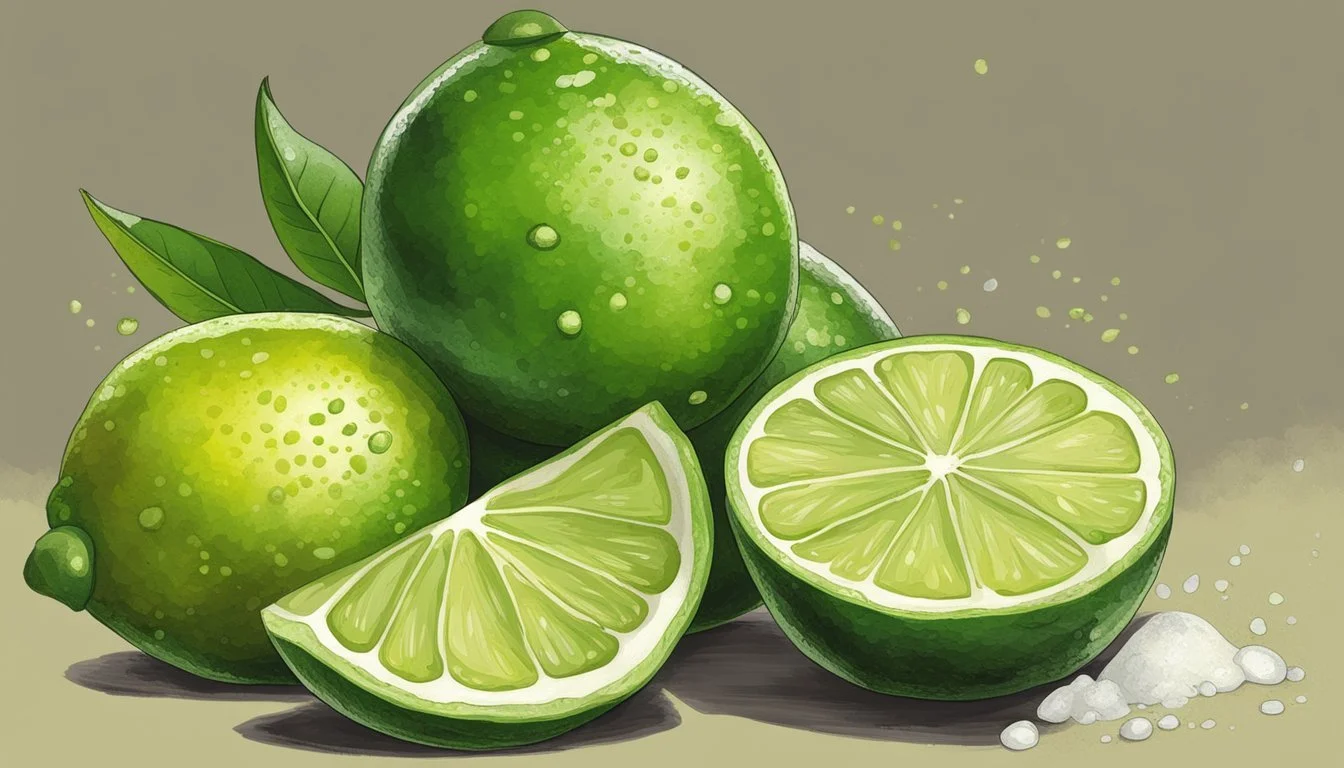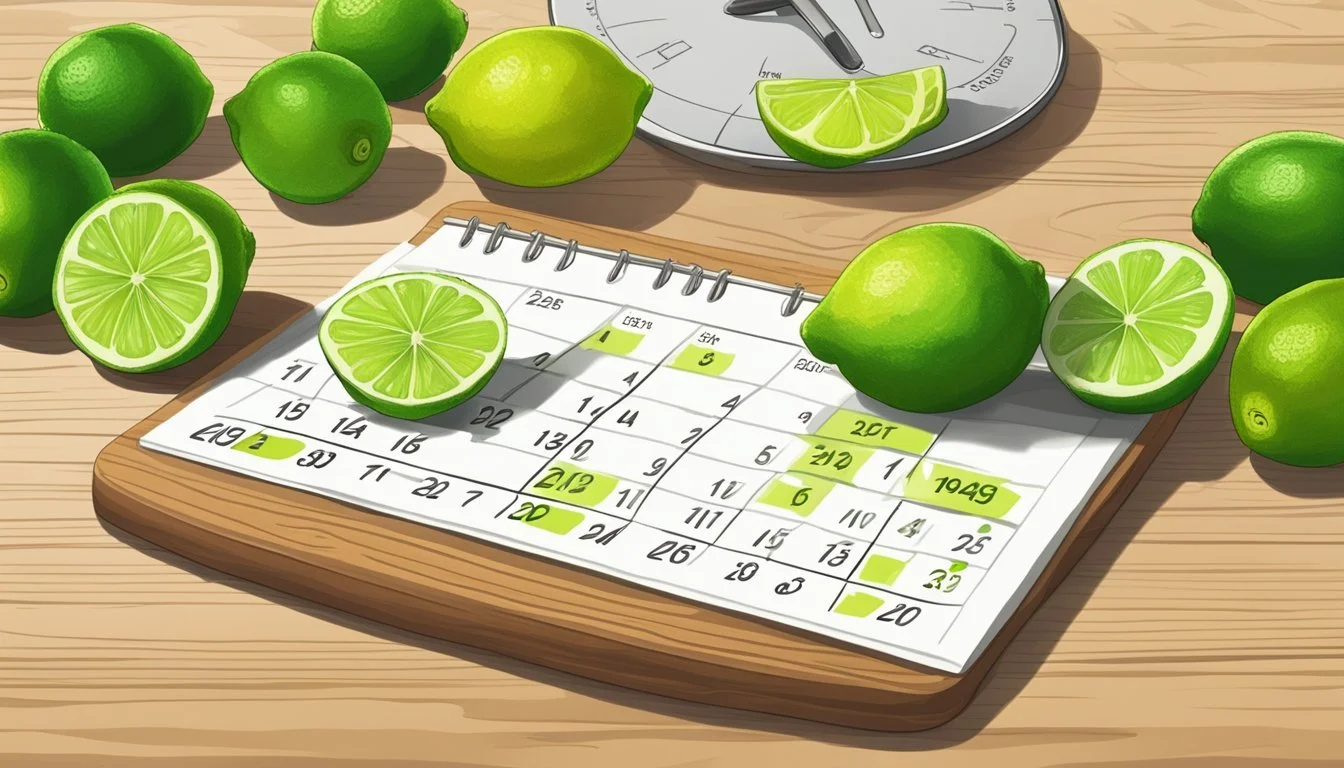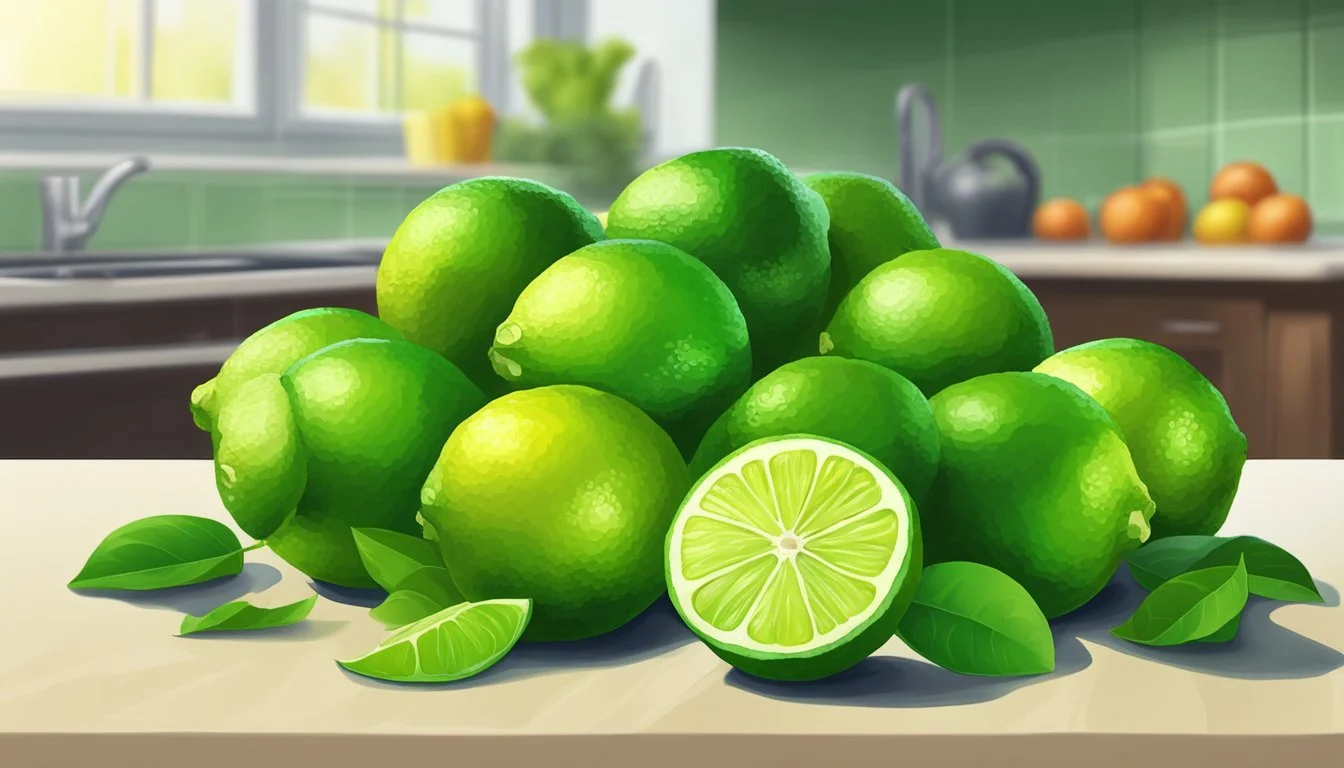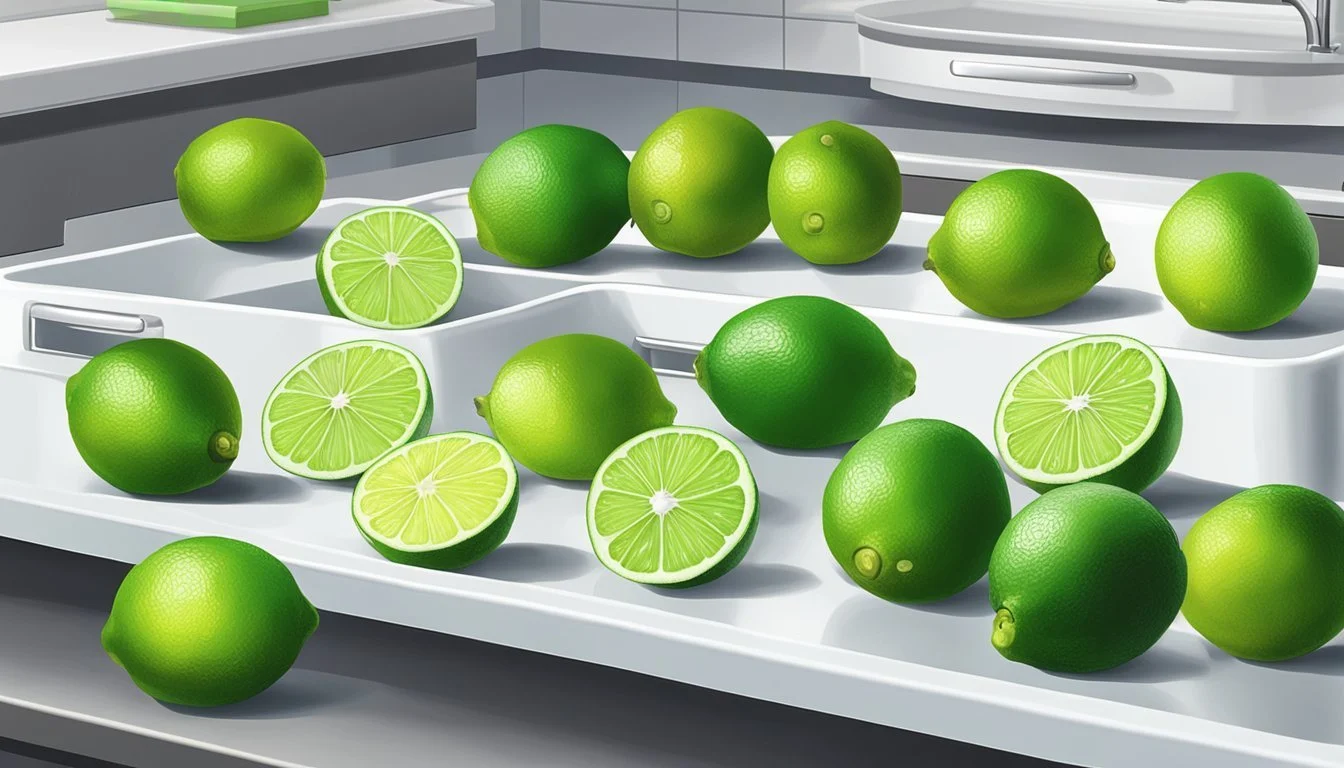How Long Do Limes Last?
A Guide to Citrus Shelf Life
Limes, with their tangy citrus flavor, are a staple in many kitchens and an essential ingredient in a variety of recipes, ranging from refreshing beverages to exotic dishes. Determining how long these fruits last is crucial for maintaining their zest and avoiding food waste. Typically, whole limes can last for a week at room temperature, making them convenient for immediate use. However, when stored properly, their shelf life can be extended, ensuring that they remain a fresh and zesty addition to meals and drinks.
To maximize their longevity, limes can be placed in the refrigerator, where the cooler temperatures slow down the degradation process. In this environment, limes have a much longer shelf life, usually lasting between 3 to 4 weeks when kept in the vegetable crisper drawer. It is also possible for them to remain in good condition for up to two months if stored correctly in a sealed container or plastic bag to retain moisture and prevent overexposure to air.
Understanding Limes
Limes are a versatile citrus fruit, treasured for their tart flavor and aromatic zest. They belong to the same family as lemons and oranges, all of which are characterized by their high vitamin C content.
Key limes are small, aromatic, and known for their intense tartness.
Mexican limes, also known as Persian limes, are larger and milder.
Limes' bright green rind encases the juicy, acidic segments within. Their sourness distinguishes them from sweeter citrus relatives like oranges and apples, making limes a unique addition to culinary dishes and beverages.
Freshness Factors:
Texture: A fresh lime should feel firm. Soft spots could indicate spoilage.
Color: They are typically green, but some varieties may yellow with age while still being edible.
Smell: Fresh limes have a citrus scent. A foul odor signifies spoilage.
Unlike apples that can last several months, or oranges with a few weeks' longevity, limes have a comparatively shorter shelf life. To maximize freshness, storage is key. Room temperature is suitable for short-term, but refrigeration can extend their life.
Storage Method Approximate Lifespan Countertop Up to 2 weeks Refrigerator Up to 4 weeks Freezer Up to 6 months
In summary, limes offer culinary creativity and nutritional benefits. However, they require proper handling to maintain their zest and prevent waste.
Factors Affecting Lime Longevity
The shelf life of limes can be influenced by several factors, from the way they're stored to their exposure to other foods. Understanding these factors ensures optimal freshness and flavor retention.
Temperature and Storage Environment
Temperature: The longevity of limes greatly depends on the storage temperature. Limes last about two weeks at room temperature and can stay fresh for up to four weeks in the refrigerator. In contrast, freezing limes can extend their shelf life to several months, especially if you freeze the lime juice in ice cube trays.
Storage: To prevent spoilage, whole limes should be kept in a produce drawer with low humidity. Sliced or cut limes should be wrapped in plastic wrap or placed in a sealed plastic bag and refrigerated, where they can last for a few days.
Lime Physical Integrity
Quality and Texture: Fresh limes should be firm to the touch. Over time, skin can discolor, and soft spots may develop, signaling spoilage. Limes with any signs of mold or changes in texture should be discarded.
Preservation Methods
Freezing: Lime juice can be preserved by freezing and ideally should be used within a few months to maintain quality. Whole frozen limes can become soft upon thawing but remain suitable for juicing.
Proper Storage: Storing limes in plastic containers or bags with some ventilation can help retain their freshness by balancing moisture content to avoid excess accumulation, which can lead to faster spoilage.
Exposure to Elements
Light and Air: Limes are sensitive to light and oxygen, both of which can speed up oxidation and degrade the quality. Storing limes in a dark, cool place minimizes exposure to these elements.
Humidity: High levels of humidity can also encourage the formation of mold. Limes should be stored in a moderately dry environment to prevent mold growth.
Food Interaction
Ethylene Gas: Limes should be stored away from fruits that emit ethylene gas, as it can accelerate ripening and spoilage.
Recipes: In dishes, the shelf life of limes or lime-containing components may not necessarily match that of the quickest expiring ingredient. For example, in fish recipes where lime is added for flavor, the dish's longevity is typically determined by the fish's freshness rather than the lime's.
Storing Limes for Optimal Freshness
To maintain the freshness of limes, proper storage methods are vital whether one is using a refrigerator, keeping them at room temperature, or opting for freezing. Let’s explore the most effective techniques to prolong the life span of limes.
Refrigeration Techniques
Storing limes in the refrigerator significantly extends their freshness. Placing whole limes in a perforated plastic bag helps maintain the right humidity levels, and keeping them in the produce drawer isolates them from ethylene gas produced by other fruits, which can hasten ripening. When refrigerated correctly, limes can last up to four weeks.
Best Practices for Refrigeration:
Use perforated plastic bags to allow airflow.
Place in the produce drawer to minimize exposure to ethylene gas.
Counter Storage Tips
If refrigeration isn't an option, storing limes at room temperature away from direct light and moisture is a suitable alternative. On the counter, they typically last about two weeks. It is essential to keep them in a well-ventilated and dry area to prevent mold growth.
Guidelines for Room Temperature Storage:
Store in a basket or ventilated container.
Keep away from sunlight and heat sources.
Proper Freezing Practices
For longer-term storage, freezing limes is an acceptable practice. Freezing lime juice in ice cube trays ensures easy access to small amounts when needed. One can also freeze whole limes or zest, if preferred. When limes are stored in the freezer properly, they can be used for up to six months without significant taste alteration.
Freezing Steps:
Juice limes and pour into ice cube trays; freeze and then store cubes in an airtight container.
Freeze whole or zested limes in airtight bags or containers.
By adhering to these specific storage methods for limes, one can ensure maximum freshness and flavor retention. Whether opting for refrigeration, room temperature storage, or freezing, each method requires a distinct approach to maintain the limes at their best quality.
Maximizing Lime Shelf Life
To ensure limes remain fresh for as long as possible, observing proper storage methods is key. The shelf life of limes can vary depending on these conditions.
At Room Temperature
Limes last up to a week and should be kept in a cool, dry place away from sunlight.
The best before date is shorter compared to refrigeration.
Refrigeration
Place whole limes in the vegetable crisper drawer of the fridge.
Shelf life extends to 3-4 weeks.
Sealing Methods
Utilizing airtight containers or vacuum-sealing bags can preserve freshness.
Freezing: Limes can be frozen either whole or as juice/zest for up to six months.
Avoiding Moisture
Keeping limes dry prevents mold growth, one of the primary causes of spoilage.
Note: Once a lime shows signs of spoilage such as mold, discoloration, softness, or a bad odor, it should be discarded.
Following these procedures will optimize the lime shelf life and maintain the fruit's quality, ensuring it is safe and enjoyable to eat.
Signs of Lime Spoilage
Recognizing when a lime has gone bad is crucial to ensure flavor and safety. There are several indicators one can identify in spoiled limes.
Texture: An initial sign is the texture of the lime. Fresh limes are firm to the touch. If one finds that the lime has soft spots or a mushy feel, it may indicate that the lime is overripe or starting to rot.
Discoloration: Another visible sign is discoloration. Spoiled limes may exhibit a brownish color or lose their uniform green shade, instead displaying yellow skin.
Mold: The presence of mold is a clear indication that a lime should not be consumed. Mold can appear as white, green, dark brown, or black spots on the skin or flesh of the lime. It can look furry or wet.
Smell: One should also be aware of any unpleasant or off smells. A fresh lime should have a citrus scent, so any deviation from this could point to spoilage.
Here's a quick reference guide to help you identify if a lime has spoiled:
Attribute Description of Spoilage Texture Soft, mushy, less firm than fresh limes Color Brown patches, yellowing, uneven color Mold White, green, dark brown, or black spots; fuzzy or slimy in appearance Smell Unpleasant, sour, or fermented odors
By paying attention to these indicators, one can ascertain the quality of limes and prevent the consumption of spoiled produce.
Usage of Lime and Lime Derivatives
Lime juice and zest are versatile ingredients used in a variety of recipes to add a tangy and zesty flavor. Chefs and home cooks alike incorporate them into dishes, knowing that even a small amount of lime can elevate a meal's taste profile.
Lime Juice: Commonly used in dressings, marinades, and beverages, lime juice adds a burst of citrus flavor that is both refreshing and balancing. It can tenderize meats in marinades and bring a sharp brightness to cocktails or homemade lemonades.
In Beverages: A staple in margaritas and mojitos.
Culinary Uses: Enhances flavors in salsa, guacamole, and seafood dishes. (What wine goes well with seafood dishes?)
Zest: The outer peel of the lime, when grated to create zest, provides a potent aromatic that infuses recipes with a citrus essence without the additional liquid or acidity of the juice.
In Baking: Used in cakes, cookies, and pastries for a subtle lime flavor.
Culinary Accent: Sprinkled over dishes before serving for added aroma.
Table of Lime Derivative Uses:
Lime Derivative Uses in Recipes Lime Juice Beverages, dressings, marinades, seafood dishes Lime Zest Baked goods, garnishing, flavoring oils and sugars
When juicing, chefs often use tools like a citrus press or a reamer to extract the maximum amount of juice efficiently. They might also add lime juice into recipes where lemon zest is used to create a dynamic citrus flavor combination.
When limes are prepared in a dish, their derivatives are known for not just imparting flavor but also for their functional benefits such as acting as a natural preservative or enhancing the absorption of iron from plant-based foods.
Health Considerations
When considering the health implications of limes, it is important to note their richness in vitamin C and antioxidants. These nutrients are known for their health benefits, including boosting the immune system and protecting against free radical damage. Limes are a low-calorie fruit and contribute to a well-balanced diet when consumed within their freshness period.
However, spoiled limes pose health risks due to potential bacterial growth, such as Salmonella or E. coli. These bacteria can cause foodborne illnesses, so it's crucial to adhere to proper food safety measures.
Below are key points related to the health considerations of consuming limes:
Vitamin C Content: Averages 29.1 mg per lime, providing about 32% of the Reference Daily Intake (RDI).
Antioxidant Availability: Contains flavonoids, which have anti-inflammatory properties.
Health Benefits: They can contribute to skin health and may lower the risk of heart disease.
To minimize health risks:
Check limes for mold, soft spots, or an off smell.
Store limes properly: Room temperature for up to 2 weeks, refrigerated for up to 4 weeks.
It is recommended that consumers be vigilant about the freshness of their limes to enjoy their nutritional benefits safely.
Reducing Food Waste
Proper storage of limes is crucial to reducing food waste. By extending the shelf life of these citrus fruits, individuals can ensure they're used rather than discarded. Limes should be stored in the refrigerator where the temperature is optimally maintained between 0 and 4° C. This environment can keep limes fresh for an extended period.
Here are key storage tips:
Ripening: Allow limes to ripen on the countertop.
Refrigeration: Once ripened, transfer limes into the fridge.
Bagging: Store uncut limes in perforated plastic bags to maintain humidity while allowing airflow.
For those with excess limes unlikely to be used promptly, consider freezing:
Slice limes into wedges.
Squeeze lime juice into ice cube trays.
Freeze and store for up to 6 months.
Avoiding Overbuying:
Purchase only the amount of limes that can be reasonably consumed.
Check for existing limes at home before buying more to prevent duplication.
When these guidelines are followed, the shelf life of limes can be maximized, thus minimizing the frequency of disposing of spoiled limes and contributing to a more sustainable approach to food consumption.
Culinary Tips and Tricks
When utilizing limes in the culinary realm, one can employ several techniques to maximize their flavor and longevity. Below are methods for integrating limes effectively into recipes while preserving their zest and juice.
Storing Limes for Freshness
Refrigeration: To retain their freshness, limes can be stored in the refrigerator for up to four weeks.
Cool and Dry: Limes last longer when kept in a cool, dry place away from direct sunlight if not refrigerated immediately.
Making the Most of Lime’s Zest and Juice
Zest: Before juicing a lime, grate the outer skin or create zest, which can be dried or frozen and used later in recipes to add a vibrant citrus flavor.
Juicing: To maximize juice output, limes can be rolled on the countertop before cutting and juicing. The juice can be stored in the refrigerator or frozen for later use.
Alternative Forms of Preservation
Lime juice can be frozen in ice cube trays, making it convenient to add a splash of lime flavor to drinks or dishes.
Zest can be mixed with salt or sugar to create citrus-infused seasonings for a variety of recipes.
Utilizing in Recipes
Replacing lemon zest with lime zest can add a unique twist to a recipe, providing a distinct tangier profile that complements sweet and savory dishes.
Lime juice is integral to many marinades, salsas, and dressings, contributing both flavor and acidity.
By masterfully storing and preparing limes, one can ensure that these citrus fruits enhance a plethora of culinary creations with their zesty flavor.
Lime FAQ
How long do limes last?
Limes typically last up to two weeks at room temperature and can last up to four weeks when refrigerated. If properly stored in the freezer, they can last up to six months.
How long are limes good for after cutting?
Once cut, limes should be used within 3-5 days even if they are refrigerated. After this period, quality and freshness may begin to decline.
How can one tell if limes have gone bad?
Mold: Appearance of white, green, or black spots, which may be on the skin or internal.
Texture: Soft spots or mushiness indicate rot.
Odor: An off or foul smell is a clear sign of spoilage.
What is the best way to store limes to extend their shelf life?
Refrigeration: Place limes in the crisper drawer of the refrigerator to maintain freshness for up to four weeks.
Freezing: For long-term storage, limes can be frozen whole, as slices, or as juice, but this may affect the texture.
Is refrigeration necessary for limes?
While not necessary, refrigeration is recommended to extend the shelf life of limes. Room temperature is suitable if they will be used within two weeks.
Conclusion
Limes, when stored properly, maintain their freshness for varying periods depending on the storage conditions. At room temperature, limes typically last about one week. However, individuals can considerably extend their shelf life by refrigerating them, where they can remain fresh for up to four weeks. The crisper drawer of a refrigerator is ideal for this purpose.
In cases where limes need to be kept for even longer, freezing is an option. While freezing might slightly alter the texture, it does preserve the lime juice effectively for three to twelve months. It's recommended to freeze the juice in ice cube trays for convenience.
For ease of reference, the storage times are summarized below:
Room Temperature: Approximately 1 week
Refrigerated: Up to 4 weeks
Freezing (Juice): 3-12 months
To ascertain whether limes have gone bad, one should look for signs of spoilage such as mold, soft spots, discoloration, or an off smell. Limes that exhibit any of these symptoms should be discarded.
By adhering to these storage guidelines, one can ensure the longevity and edibility of limes, reducing waste and preserving their vibrant flavor for future culinary use.











